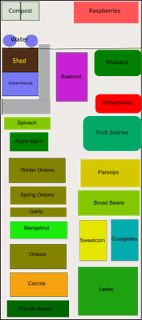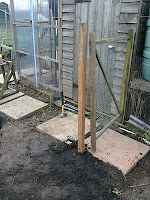We planted the remaining parsnips out today. They look puny, but they should be fine. The first batch of sweet peas were big enough to go out two to a cane.
The weather forecast is for heavy rain in a few days, I hope they are right. The local weather forecaster is hoping for no rain to set a new record for minimum rainfall in March. I hope he is disappointed.
The allotment diary. What happens when, what works, what doesn't on plot 18 of Swanland allotments.
Monday 28 March 2011
Friday 25 March 2011
Going well
We took the remaining pots of leeks from the first batch of sowing up to the greenhouse along with the second batch of parsnips. The parsnips will need to grow a little before they go out. The second batch of leeks have been potted. When they have settled down they will follow the first batch up to the greenhouse.
The newly planted parsnips look great. The soaking we gave to a few areas of the plot are still visible. The second asparagus spear has appeared but is still too small to cut. I put up a string of CDs to keep the birds off the onions. Pigeons and crows sometimes pull up the onion sets when they see the tops poking out of the soil. Once they sprout they are safer, the birds don't seem to like onions.
The newly planted parsnips look great. The soaking we gave to a few areas of the plot are still visible. The second asparagus spear has appeared but is still too small to cut. I put up a string of CDs to keep the birds off the onions. Pigeons and crows sometimes pull up the onion sets when they see the tops poking out of the soil. Once they sprout they are safer, the birds don't seem to like onions.
Wednesday 23 March 2011
Plantings, insects and nuts
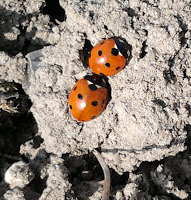 The unusually warm weather has encouraged us to plant some of the hardy plants out. It has also stirred the insects and birds. Around Plot 18 there are great tits, robins, blue tits, dunnocks, sparrows and blackbirds all showing signs of pairing up and gathering nesting materials. The winter flocks of tits have broken up. We saw a crow flying past struggling to stay airborne under the load of the stick it was carrying. Insects and spiders are on the move, with a particularly large number of ladybirds this year. We've see our first bees and butterflies and spiders race for cover with almost every footstep on the ground.
The unusually warm weather has encouraged us to plant some of the hardy plants out. It has also stirred the insects and birds. Around Plot 18 there are great tits, robins, blue tits, dunnocks, sparrows and blackbirds all showing signs of pairing up and gathering nesting materials. The winter flocks of tits have broken up. We saw a crow flying past struggling to stay airborne under the load of the stick it was carrying. Insects and spiders are on the move, with a particularly large number of ladybirds this year. We've see our first bees and butterflies and spiders race for cover with almost every footstep on the ground.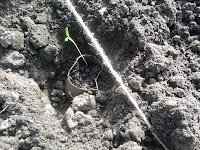 We took up some leeks, spinach and sweet peas up to the greenhouse. Our leeks have potted up particularly well this year, looking strong and upright. The earliest batch of parsnips had the tips of their roots showing at the bottom of their tubes so they had to go into the ground to keep the disturbance of that root to a minimum. Jean used a bulb-planter to cut a hole in the freshly raked soil to drop the parsnip, tube-and-all, into the ground, then carefully fill in around the tiny plant to cover the cardboard tube. The tube will quickly rot away if it is buried.
We took up some leeks, spinach and sweet peas up to the greenhouse. Our leeks have potted up particularly well this year, looking strong and upright. The earliest batch of parsnips had the tips of their roots showing at the bottom of their tubes so they had to go into the ground to keep the disturbance of that root to a minimum. Jean used a bulb-planter to cut a hole in the freshly raked soil to drop the parsnip, tube-and-all, into the ground, then carefully fill in around the tiny plant to cover the cardboard tube. The tube will quickly rot away if it is buried.The leeks will sit in the greenhouse for some weeks until they are a thick as a pencil before they go out, the spinach might take a couple of weeks but some of the sweet peas will be ready to go out sooner than that. I'm going to try training each sweet pea up a single cane this year to see if that will work.
Some years ago I gathered a few seeds in the autumn: some acorns and hazel nuts and a few holly, rowan and whitebeam berries. many of them grew in pots, not the holly, and when we got the allotment I transplanted a few around the edges of the plot. This year we have our first female flowers on the hazel. They are tiny flowers (sorry about the picture) and there are a few male catkins around. I tried to dust the flowers with pollen from the catkins because with luck we will get a few hazel nuts. Not what I had expected to grow on the allotment, but why not?
Monday 21 March 2011
Broad beans, onions and water
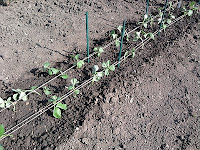 | |
| Broad beans |
 | |
| Winter Onions |
While Jean planted the onion sets in neat rows, guided by a string line, I watered the asparagus, strawberries, garlic and winter onions. As I watered the asparagus I noticed the first spear has just emerged, so the season will soon start for real. The winter onions are beginning to look a bit stronger after sitting under snow for weeks.
Sunday 20 March 2011
Using the tube
For the past few years we have chitted our parsnips and then grown the sprouted seeds on in a pot or a cardboard tube before planting them out. This year we have done the same again. The first batch of 26 have sprouted, been potted, or should that be tubed, and are now in the greenhouse, with the second batch sprouted and tubed. They will go up to the greenhouse as soon as the leaves appear.
The plot looks tidy but very, very dry. There has been little rain since the snow in November and December. We will need to water extensively before we plant anything out and then keep watering until it rains. The forecast is not just dry for the week ahead but warmer, so the broad beans might well go out shortly, but only with a lot of water.
The first batch of leeks have been potted into individual pots today. When they have got over the shock they will go up to the greenhouse to gently grown on for a few weeks before the go out.
We now need to water the asparagus and strawberries to ensure a decent crop of each this year.
The plot looks tidy but very, very dry. There has been little rain since the snow in November and December. We will need to water extensively before we plant anything out and then keep watering until it rains. The forecast is not just dry for the week ahead but warmer, so the broad beans might well go out shortly, but only with a lot of water.
The first batch of leeks have been potted into individual pots today. When they have got over the shock they will go up to the greenhouse to gently grown on for a few weeks before the go out.
We now need to water the asparagus and strawberries to ensure a decent crop of each this year.
Friday 18 March 2011
Spruce up
The fencing job has left us with a pile of rubbish: old, mangled wire fencing, some broken, rotted fence posts and a couple of old rotten gates. We swept them up into the trailer this morning and took them to the local tip to be recycled.
The broad beans and sweet peas in the greenhouse are doing well, the beans are about ready to be planted out if the weather stays warm.
The broad beans and sweet peas in the greenhouse are doing well, the beans are about ready to be planted out if the weather stays warm.
Saturday 12 March 2011
A Plan
The plot is secure and dug over. We already have some winter and perennial crops on the plot and some annuals are already sown, with some growing well. The trouble is that there's no plan as to where everything will go, or al least there wasn't until now.
The newly moved raspberries have made some more space, but somehow it's just been used. We need a big space for leeks and onions, the carrots are speculative and may come to nothing. The sweetcorn and courgettes are best in blocks, so there may be some wiggle room there. The beetroot may spread into some of the space near the strawberries. There's no space for sweet peas - they may go outside of the fence but be protected by a wire cage.
Now we just need it to be a bit warmer and a good downpour and we're all set to go.
The newly moved raspberries have made some more space, but somehow it's just been used. We need a big space for leeks and onions, the carrots are speculative and may come to nothing. The sweetcorn and courgettes are best in blocks, so there may be some wiggle room there. The beetroot may spread into some of the space near the strawberries. There's no space for sweet peas - they may go outside of the fence but be protected by a wire cage.
Now we just need it to be a bit warmer and a good downpour and we're all set to go.
Tuesday 8 March 2011
Fenced in
The new, step-over fence is now in place, though it needs a bit of finishing off. It is wired along the top for extra support and when I have finished adding a wire along the middle it will be firm and robust. The bottom of the fence is buried in a trench to deter burrowing under it. The joins are trapped between two battens screwed together for strength and to stop the stray ends of wire snagging passers-by.
Meanwhile Jean finished the digging, with the whole plot now dug over, except for where the winter onions, garlic and asparagus are. The broad beans are now safely in the greenhouse to slow down their growth a bit before they are ready to go out.
All that remains is to take the pile of old fencing and some other rubbish to the local tip and we are ready for the new season.
Meanwhile Jean finished the digging, with the whole plot now dug over, except for where the winter onions, garlic and asparagus are. The broad beans are now safely in the greenhouse to slow down their growth a bit before they are ready to go out.
All that remains is to take the pile of old fencing and some other rubbish to the local tip and we are ready for the new season.
Sunday 6 March 2011
Measuring the size of it
Much of the digging over of the plot has been done. The first part of the fence has been moved, leaving the fruit bushes outside of the fence. I have now measured up the old split and damaged wire fence and I need about 20m to replace it. I'll see what I can find over the next week. We need the fence replaced before we plant anything out, but that's a few weeks off yet so no great rush. As the old fence is removed it is a chance to cut and edge the grass paths around the plot before the new fence is installed. The new battery strimmer should get an outing for just that purpose.
Friday 4 March 2011
Old bean
All of the broad beans have sprouted. They are growing so quickly in the kitchen that they will soon need to be taken to the cold greenhouse to stop them becoming too leggy. One thing to mention is that these are not growing from beans saved from last year's crop - they got eaten by weevils. These are beans saved from 2009's crop. So eighteen months stored and they all germinate.
The garlic we grew last year looked enough to last until the next crop is ready, as it did last year. Unfortunately it has all spontaneously rotted, in both of the places we store it. So it looks as though the tough growing season last year has left us with weak garlic bulbs as well as all of the other poor crops.
I have put up the temporary table in a spare bedroom to hold some of the trays for allotment seeds and garden seeds that abound for the next few months. Now it just needs to be a bit warmer ...
The garlic we grew last year looked enough to last until the next crop is ready, as it did last year. Unfortunately it has all spontaneously rotted, in both of the places we store it. So it looks as though the tough growing season last year has left us with weak garlic bulbs as well as all of the other poor crops.
I have put up the temporary table in a spare bedroom to hold some of the trays for allotment seeds and garden seeds that abound for the next few months. Now it just needs to be a bit warmer ...
Wednesday 2 March 2011
Digging, gates, fences and holes
 Jean continued to dig over the plot. We guessed she has probably done about 30% now. The soil is damp and breaks up nicely without being too sticky, so it seems a good time to be digging. We haven't finalised the layout of the crops this year yet - we need a plan. I have added some blood fish and bone to one area Jean dug over and to the asparagus bed but until I know where things like carrots and parsnips are going I'll not add any more because they don't like it.
Jean continued to dig over the plot. We guessed she has probably done about 30% now. The soil is damp and breaks up nicely without being too sticky, so it seems a good time to be digging. We haven't finalised the layout of the crops this year yet - we need a plan. I have added some blood fish and bone to one area Jean dug over and to the asparagus bed but until I know where things like carrots and parsnips are going I'll not add any more because they don't like it.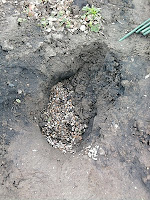 |
| Remains of the rabbit hole |

The village has the first signs of blossom showing, crocuses are out in the verges and daffodils are rapidly pushing up. On our plot the blackcurrant and gooseberry buds are opening up and the rhubarb is starting to push through. We'll see if there are any raspberries that have survived - there do look to be a couple of canes with buds. The strawberries have suffered by being half buried by the excavations made by the rabbits, but some should be fine.
I'm looking forward to getting some stuff in the ground, but as always the preparation is important and that's not finished yet.
Tuesday 1 March 2011
Subscribe to:
Posts (Atom)

